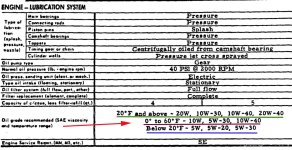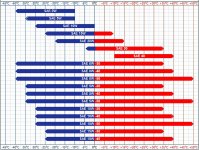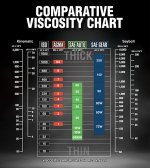You are using an out of date browser. It may not display this or other websites correctly.
You should upgrade or use an alternative browser.
You should upgrade or use an alternative browser.
Lets Talk about Oil...
- Thread starter Tinkydo
- Start date
Chuffer
CCCUK regional rep
As a new user you will not have seen the lengthy debate on oils some time ago on this forum . I am totally with Roscobbc on this one . Valvoline VR 1 is the only oil I will use in my 1980 small block C3 .Hi Everyone,
I'm new!! I've a C3 454 1973 and need to do an oil replacement, I'm now overwhelmed by the number of differences of opinion on what oil and what type. Is there anyone else running a '73 454 and if so what oil are you using please?
Thank you.
James Vette
CCCUK Member
I use halfords classic car oil.
Chuffer
CCCUK regional rep
I think you will find that Halfords Classic oil does not have the higher levels of ZDDP recommended for older engines . Valvoline VR1 20 w / 50 Race oil does .I use halfords classic car oil.
Roscobbc
Moderator
It was time to buy some Valvoline Racing VR1 20W-50 mineral for the Vette annual spring oil and filter change.
Local(ish) stockist to me, Burton Performance in Ilford had stock in 5 ltrs containers only and wanted £45 collected.
Opie Oils who historically seem to have the keenest prices only had 1 ltr containers - (no 5 ltrs in stock).
Pipercross had 5 ltr @ £31.99 + shipping but no 1 ltr ( I wanted one of each)
Ended-up ordering 2 no. 5 ltr containers from Taynar Batteries @ £64.96 including carriage (£32.48 each effectively)
Local(ish) stockist to me, Burton Performance in Ilford had stock in 5 ltrs containers only and wanted £45 collected.
Opie Oils who historically seem to have the keenest prices only had 1 ltr containers - (no 5 ltrs in stock).
Pipercross had 5 ltr @ £31.99 + shipping but no 1 ltr ( I wanted one of each)
Ended-up ordering 2 no. 5 ltr containers from Taynar Batteries @ £64.96 including carriage (£32.48 each effectively)
teamzr1
Supporting vendor
Hi Everyone,
I'm new!! I've a C3 454 1973 and need to do an oil replacement, I'm now overwhelmed by the number of differences of opinion on what oil and what type. Is there anyone else running a '73 454 and if so what oil are you using please?
Thank you.
Here is what GM engineering recommended for model year 1973 using a SAE rated oil

You might want to consider in your choice is the viscosity of the oil as to weather and if racing or spirited driving
Thinner oil flows more volume so it will stay cooler
Thicker weight flows slowly, so it retains more heat and could reduce fuel mileage a bit as more friction of parts
Thinner oil at high RPMs becomes blowby so would not want it for racing / higher RPMs
Clearance of piston rings to cylinder walls was not as good as today's engines to a thinner weight with lots of miles
on engine has better chance of slipping past the rings
As you see from what GM recommends you have enough choices of what to use and when
Stingray
CCCUK Member
I'm usually a stickler for "what the manufacturer recommended".
However, having once bought and used Halfords Classic 20-50 I can say that at ambient temperatures it's like pouring glue compared with modern motor oils. I'd be very tempted to use a modern motor oil of similar weight instead. (Definitely not the thin oils for today's cars with fancy overhead cams and narrow oilways!)
However, having once bought and used Halfords Classic 20-50 I can say that at ambient temperatures it's like pouring glue compared with modern motor oils. I'd be very tempted to use a modern motor oil of similar weight instead. (Definitely not the thin oils for today's cars with fancy overhead cams and narrow oilways!)
Roscobbc
Moderator
I always thought the whole 'thing' about multigrade oils was they had the characteristic of varying their viscosity rating depending of ambient and engine temperatures. A 20w50 may be a little 'gloopy" at low temperatures it will still have its rated viscosity at elevated running temperatures.I'm usually a stickler for "what the manufacturer recommended".
However, having once bought and used Halfords Classic 20-50 I can say that at ambient temperatures it's like pouring glue compared with modern motor oils. I'd be very tempted to use a modern motor oil of similar weight instead. (Definitely not the thin oils for today's cars with fancy overhead cams and narrow oilways!)
Roscobbc
Moderator
I always thought the whole 'thing' about multigrade oils was they had the characteristic of varying their viscosity rating depending on ambient and engine temperatures. A 20w50 may be a little 'gloopy" at low temperatures but will still have its rated viscosity at elevated running temperatures.
Chuffer
CCCUK regional rep
Hit the nail on the head there Roscobbc . We have had this " what oil" debate going round and round for ages now and several of us swear by Valvoline VR1 Racing 20W 50 as do you . The guy who runs PJM Preparations where I keep my Vette who maintains a fleet of race cars and has a lifetimes experience in motorsport actually said to me that he was pleased to see i was using "the right stuff " the first time he saw me doing an oil change on the C3 . So that`s more than enough for me . 
teamzr1
Supporting vendor
Oil viscosity is the most important property of a lubricant.
Understanding viscosity promotes the ability to reduce wear, improve fuel economy, and make more horsepower.
For starters, in oil nomenclature, “W” does not stand for “Weight”.
It stands for “Winter” and that is the key to understanding viscosity grades.
A 10W-30 is a multi-grade (two viscosity) motor oil, and as the name implies, it meets more than one grade.
Forty years ago, there were winter grades for cold weather and summer grades for warmer weather.
A typical winter grade was 10W. A typical summer grade was 30.
These oils were straight grade oils. A 10W flows well in cold weather, to protect the engine at start up, but it is too thin for use in the summer.
A 30 grade oil, thick enough to protect in the heat, was recommended for summer use.
Then, multi-grade oils were formulated.
A 10W-30 had the winter cold start flow properties of a 10W and the summer, high-temperature thickness of a 30 grade.
Multi-grade oils could stay as close to the optimum viscosity over a range of temperatures, not too thick when it is cold and not too thin when it is hot.
The difference between a 0W-30 and a 10W-30 is indicated by how well each flows at lower temperatures.
The viscosity of hot oil is measured using different test parameters than when the oil is cold, so the numbers after the “W” don’t relate to the numbers in front of the “W”.
The difference between 10W-30 and a 10W-40 is the high temperature viscosity. Obviously, a 10W-40 is thicker than a 10W-30 at high temperature.
Armed with knowledge of viscosity grades, how can we put it to good use?
Remember that using oil with a viscosity that is too high can result in excessive oil temperature and increased drag (loss of performance)
Using an oil with a low viscosity can lead to excessive metal to metal contact between moving parts.
Using the correct viscosity oil eases starting, reduces friction, and slows wear.
For even more effective start-up protection, use a synthetic 10W-40 instead of a conventional 20W-50.
The synthetic 10W-40 flows easily and still maintains enough viscosity to protect piston skirts and bearings when it gets hot.
The improved temperature stability of synthetics makes them a better choice for race engines and serious high-performance engines.
Even with a synthetic, however, viscosity changes with temperature. Selecting the correct viscosity for an application requires knowing the operating temperature of the oil. Engines that run high operating oil temperatures require higher viscosity oil.
The difference between a 0W-30 and a 10W-30 is indicated by how well each flows at lower temperatures.
The viscosity of hot oil is measured using different test parameters than when the oil is cold, so the numbers after the “W” don’t relate to the numbers in front of the “W”.
The difference between 10W-30 and a 10W-40 is the high temperature viscosity.
Obviously, a 10W-40 is thicker than a 10W-30 at high temperature.
Armed with knowledge of viscosity grades, how can we put it to good use? Remember that using oil with a viscosity that is too high can result in excessive oil temperature and increased drag. Using an oil with a low viscosity can lead to excessive metal to metal contact between moving parts.
Using the correct viscosity oil eases starting, reduces friction and slows wear.
Armed with knowledge of viscosity grades, you can now select the right one for your application.
In return, you will prevent wear, improve fuel economy, and make more horsepower

Understanding viscosity promotes the ability to reduce wear, improve fuel economy, and make more horsepower.
For starters, in oil nomenclature, “W” does not stand for “Weight”.
It stands for “Winter” and that is the key to understanding viscosity grades.
A 10W-30 is a multi-grade (two viscosity) motor oil, and as the name implies, it meets more than one grade.
Forty years ago, there were winter grades for cold weather and summer grades for warmer weather.
A typical winter grade was 10W. A typical summer grade was 30.
These oils were straight grade oils. A 10W flows well in cold weather, to protect the engine at start up, but it is too thin for use in the summer.
A 30 grade oil, thick enough to protect in the heat, was recommended for summer use.
Then, multi-grade oils were formulated.
A 10W-30 had the winter cold start flow properties of a 10W and the summer, high-temperature thickness of a 30 grade.
Multi-grade oils could stay as close to the optimum viscosity over a range of temperatures, not too thick when it is cold and not too thin when it is hot.
The difference between a 0W-30 and a 10W-30 is indicated by how well each flows at lower temperatures.
The viscosity of hot oil is measured using different test parameters than when the oil is cold, so the numbers after the “W” don’t relate to the numbers in front of the “W”.
The difference between 10W-30 and a 10W-40 is the high temperature viscosity. Obviously, a 10W-40 is thicker than a 10W-30 at high temperature.
Armed with knowledge of viscosity grades, how can we put it to good use?
Remember that using oil with a viscosity that is too high can result in excessive oil temperature and increased drag (loss of performance)
Using an oil with a low viscosity can lead to excessive metal to metal contact between moving parts.
Using the correct viscosity oil eases starting, reduces friction, and slows wear.
For even more effective start-up protection, use a synthetic 10W-40 instead of a conventional 20W-50.
The synthetic 10W-40 flows easily and still maintains enough viscosity to protect piston skirts and bearings when it gets hot.
The improved temperature stability of synthetics makes them a better choice for race engines and serious high-performance engines.
Even with a synthetic, however, viscosity changes with temperature. Selecting the correct viscosity for an application requires knowing the operating temperature of the oil. Engines that run high operating oil temperatures require higher viscosity oil.
The difference between a 0W-30 and a 10W-30 is indicated by how well each flows at lower temperatures.
The viscosity of hot oil is measured using different test parameters than when the oil is cold, so the numbers after the “W” don’t relate to the numbers in front of the “W”.
The difference between 10W-30 and a 10W-40 is the high temperature viscosity.
Obviously, a 10W-40 is thicker than a 10W-30 at high temperature.
Armed with knowledge of viscosity grades, how can we put it to good use? Remember that using oil with a viscosity that is too high can result in excessive oil temperature and increased drag. Using an oil with a low viscosity can lead to excessive metal to metal contact between moving parts.
Using the correct viscosity oil eases starting, reduces friction and slows wear.
Armed with knowledge of viscosity grades, you can now select the right one for your application.
In return, you will prevent wear, improve fuel economy, and make more horsepower

Stingray
CCCUK Member
Sounds ideal to me - correct spec' and, as a fully synthetic, a whole lot more modern.Hit the nail on the head there Roscobbc . We have had this " what oil" debate going round and round for ages now and several of us swear by Valvoline VR1 Racing 20W 50 as do you .
Engines chew up the long chain molecules of mineral oils quite quickly and the oil loses its lubricating properties. The long chain molecules in synthetics are much tougher - hence manufacturers' confidence in 2 year/20,000 miles intervals for normal road cars.
teamzr1
Supporting vendor
Considering there are multiple standards (that use different scales) for designating viscosity, a comparative viscosity chart can help determine if two or more lubricants have similar viscosities.
But how do you read a gear oil viscosity chart?
Just read it horizontally. For example, an SAE 60 motor oil has a similar viscosity to an SAE 90 gear oil, an AGMA 6 gear lubricant and an ISO 320 hydraulic fluid/gear lubricant.
The corresponding kinematic viscosity and Saybolt viscosity are also referenced on the chart.
Kinematic Viscosity
Commonly seen on a lubricant’s data sheet, kinematic viscosity describes a fluid’s visible tendency to flow.
Think of this as the time it takes to watch a fluid pour out of a container.
This tendency to flow is expressed in units suggesting the volume of flow over time, called centistokes (cSt).
Kinematic viscosity is usually tested at both 40°C and 100°C.
Saybolt Viscosity
Although centistokes are the most common unit of measurement when determining kinematic viscosity, results may also be reported in Saybolt Universal Seconds (SUS).
Viscosity reported in SUS is becoming increasingly rare, but you may still come across it when reading lubricant product information. Saybolt viscosity is usually tested at both 100°F and 210°F.
Comparative Gear Oil Viscosity Chart

But how do you read a gear oil viscosity chart?
Just read it horizontally. For example, an SAE 60 motor oil has a similar viscosity to an SAE 90 gear oil, an AGMA 6 gear lubricant and an ISO 320 hydraulic fluid/gear lubricant.
The corresponding kinematic viscosity and Saybolt viscosity are also referenced on the chart.
Kinematic Viscosity
Commonly seen on a lubricant’s data sheet, kinematic viscosity describes a fluid’s visible tendency to flow.
Think of this as the time it takes to watch a fluid pour out of a container.
This tendency to flow is expressed in units suggesting the volume of flow over time, called centistokes (cSt).
Kinematic viscosity is usually tested at both 40°C and 100°C.
Saybolt Viscosity
Although centistokes are the most common unit of measurement when determining kinematic viscosity, results may also be reported in Saybolt Universal Seconds (SUS).
Viscosity reported in SUS is becoming increasingly rare, but you may still come across it when reading lubricant product information. Saybolt viscosity is usually tested at both 100°F and 210°F.
Comparative Gear Oil Viscosity Chart

HJG
Well-known user
The SAE bands are quite wide and grades definitely overlap.
For example a 0w/40 and a 5w/40 are likely identical viscosity when cold, the difference being the 0w is 'rated' (tested) to -40degC whilst the 5w at -35degC. Other than that likely no appreciable difference in the viscosity profiles
With wide bands allow the oil manufacturer to either lean on the thin or thick side of the allowable viscosity. Oils developed alongside road car engines are likely to be on the thinner side for fuel efficiency, whereas 'aftermarket and motorsport oils will be on the thicker side.
For example a 0w/40 and a 5w/40 are likely identical viscosity when cold, the difference being the 0w is 'rated' (tested) to -40degC whilst the 5w at -35degC. Other than that likely no appreciable difference in the viscosity profiles
With wide bands allow the oil manufacturer to either lean on the thin or thick side of the allowable viscosity. Oils developed alongside road car engines are likely to be on the thinner side for fuel efficiency, whereas 'aftermarket and motorsport oils will be on the thicker side.
